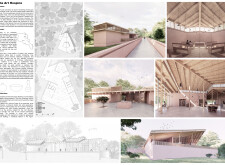5 key facts about this project
## Overview
Located in the Dilijan Municipality of Tavush Province, Armenia, The Art Hospice serves as a convergence of art, health, and the natural environment. The project aims to foster a supportive atmosphere for therapeutic practices while promoting an appreciation for local crafts and nature. The design integrates elements of Armenian cultural heritage, particularly the traditions of pottery and ceramics, to create a space that encourages both artistic engagement and personal reflection.
## Spatial Organization and User Experience
The architectural composition features three distinct structures arranged thoughtfully across a flat plateau, ensuring functional coherence while enhancing the visitor experience. The entrance area invites guests into the communal zones of the hospice, emphasizing accessibility and warmth. Therapy rooms are minimally furnished to promote tranquility, while flexible art studios accommodate a variety of creative activities, such as painting and pottery. This spatial configuration caters to individual therapeutic needs and fosters collaborative artistic expression.
## Materiality and Sustainability
The selection of materials for The Art Hospice reflects a commitment to regional authenticity and sustainability. Concrete serves as a durable structural base, allowing for innovative forms, while extensive use of wood throughout the roofing and interiors reinforces a connection to the natural surroundings. The incorporation of local clay plaster not only honors traditional Armenian building techniques but also grounds the hospice in its context. Ample glass surfaces facilitate natural light influx, enhancing the sense of openness and connection to the landscape, thereby promoting a tranquil and inviting atmosphere.


















































